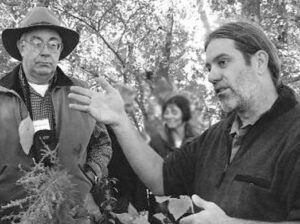On October 27, 2006, the Greater Piedmont Chapter of the Explorers Club sponsored an expedition to historical and archaeological sites along the Wateree River. The first stop was the Adamson Mounds Site.
This sacred Indian burial site entered the National Register of Historic Places in 1970. It is one of 14 federal and state protected sites in South Carolina. The large pre-Columbian mound is located on the east bank of the Wateree River near Camden.
Chris Judge, an archaeology professor at USC-Lancaster, formerly archaeologist for the S.C. Department of Natural Resources Heritage Program, gave the 50 participants a brief history of Indian mounds.
Some Indians in pre-Columbian South Carolina built burial mounds for chiefs, shaman, and warriors. A structure made of wooden poles was placed on top of the mound to protect the body. Relatives hung offerings, such as rattles and feathers on the poles. The height of the burial mound indicated the importance of the deceased.
Other Indians, such as those who built the Adamson Mound, built mounds as temples or royal centers. They were part of the Cofitachequi chiefdom, which controlled the Wateree River area at the time of DeSoto’s expedition in 1540.
Earthen mounds were constructed of dirt carried in baskets on the backs of people. Stick and thatch temples were constructed on top of the mound. The temple contained an altar, which held sacred objects used by the priests. As the temples collapsed or burned, more dirt and temples were added increasing the height of the mound.
There were many mounds in the area. Some of the mounds would have been flat-topped with a temple or public (rather than private) structure on top. Most of these have been destroyed over time.
We hiked to the top of the mound and were able to distinguish the remains of several other mounds and numerous ponds and fields. Through the trees, we could barely catch a glimpse of the Wateree River.
Back on ground level, Tom Mancke, naturalist in-residence at Hammond School and an expert on primitive technology, instructed us on pre-Columbian technology. He demonstrated how the Native Americans utilized their natural environment to make their tools and weapons.
As a finale, Mancke gathered a piece of flint, an animal bone, and strips of bark. In a few moments, he had a ball of fire in his hands, proof that fire could be started without matches. He smudged his forehead with ashes from the fire and led the group in a chant for peace and appreciation of nature’s gifts.





I love tge History of SOUTH CAROLINA and yarn to learn more about our ancient past. Despite all of its faults, South Carolina is/was truly blessed. I am thankful that our State Government supports further research and recording of its ancient History . Thank you for spreading the word in these informative post so that all can learn of her true history.